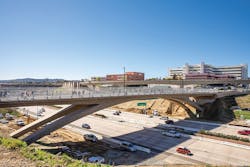NO. 9: Gilman Drive Bridge
A unique three-span concrete arch bridge was chosen for the Gilman Drive Bridge as the preferred design due in part to the architecture of other bridges in the region.
The Gilman Bridge site was also uniquely situated to support an arch structure, with the slope on either side of I-5 capable of anchoring thrust forces from the arch. The project was contracted by University of California, San Diego, as it connects its west campus with its east campus.
To address the low stiffness of the foundations, two important changes were made to the bridge: Micropiles were used to transfer arch thrust loads to stronger and deeper subsurface materials, and the footings were connected to the footings with inclined struts.
Since the Gilman Drive Bridge uses standard cast-in-place box girder design principles, the superstructure was designed and checked using the same methods implemented for other bridges throughout California. However, arch action creates compressive forces at mid-span of the bridge and tension forces in the back span that added an unconventional wrinkle to the design. The axial forces were simply incorporated into the provisions for shear and flexure and were altogether similar to post-tensioning effects on a typical structure. However, at the arch crown, accurate computer modeling proved indispensable in determining the proper staged construction sequence.
While the inclined struts were added to resist gravity loads, they also changed the seismic response of the bridge. The strut tied the footings into the abutment and by doing so created a large transverse diaphragm that resists lateral displacement. The period of the bridge was therefore reduced, and the maximum transverse displacement dropped from 9 in. to 5 in.
Despite the design challenges, the project team adapted and was able to come up with an innovative and usable solution to create a unique and landmark bridge for the client and community.
